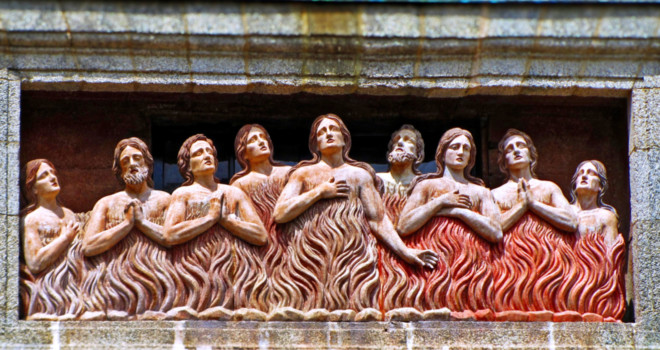St. Faustina (d. 1938), shown purgatory by her guardian angel, once recalled: “I was in a misty place full of fire in which there was a great crowd of suffering souls. They were praying fervently for themselves, but to no avail; only we can come to their aid. . . . I asked these souls what their greatest suffering was. They answered me in one voice that their greatest torment was longing for God” (Diary, 20).
What does the Catholic Church teach about purgatory?
Jesus by His Cross atoned for our sins, and His mercy forgives our sins if we repent of them. God’s justice, however, requires us to suffer a purification of our sins’ consequences. If we do not satisfy God’s justice in this life, God allows us to satisfy it in the next – in purgatory, where God’s mercy and justice meet.
The reality of purgatory is a definitive teaching of the Church binding upon the belief of all Catholics, as pronounced by the Catechism of the Catholic Church:
1030. All who die in God’s grace and friendship, but still imperfectly purified, are indeed assured of their eternal salvation; but after death they undergo purification, so as to achieve the holiness necessary to enter the joy of heaven.
1031. The Church formulated her doctrine of faith on purgatory especially at the Councils of Florence and Trent. The tradition of the Church, by reference to certain texts of Scripture, speaks of a cleansing fire.
Among the many authoritative attestations over the centuries to the necessity of purgatory is that of Church Father, Pope St. Gregory the Great (d. 604): “We must believe that before the final judgment there is a purifying fire.”
Why do we the need to talk about purgatory today?
Although the reputable PEW Research Center recently found that some seventy percent of Catholics know that purgatory is a place of purification for souls unready for heaven, it is evident that most Catholics have an insufficient awareness and understanding of purgatory. With the decline today in basic catechesis and an inordinate emphasis on God’s mercy to the diminishment of His justice, the idea of a need for a painful purgation before entry into heaven has become increasingly regarded as harsh and regressive, as inconsequential or simply untrue.
Do we not regularly conduct our deceased immediately to heaven with no acknowledgment of their likely need of purgatory? Such misunderstanding demotivates acts of suffrage, of prayer and sacrifice, for the dead, and of reparation for ourselves by which the time and travail in purgatory might be reduced or even eliminated. A matter very consequential for those either bound in or for purgatory.
What and where is purgatory?
Because the souls in purgatory are pure spirits, it is a state of being, not a physical “place,” which will be dissolved on the Last Day when any souls still there will go to Heaven. The many visions of purgatory by saints – as affirmed in Church tradition but not specifically binding on the belief of the faithful – tend to agree that it contains diverse environments, from fiery hot to frigidly cold chambers, arid to swampy strands, and even verdant fields for those closest to heaven.
The “Apostle of Purgatory,” St. Catherine of Genoa (d. 1500), describes purgatory from a vision she was granted as divided into three levels to which souls are consigned according to the severity and number of their unexpiated sins: from a deep and dark, fiery pit with many forms of severe torture, like unto Hell, where souls suffer longest; to a murky and barren region where souls endure more moderate pains for a shorter time; to a brighter realm of little or no pain where souls stay for a briefer time — all aching to be with God.
Who is in purgatory?
Baptized persons – including those with “baptism of desire” and “of blood” – who have accepted God’s merciful forgiveness and died in the state of grace, but who have not made full expiation for their sins or have died with unrepented venial sins, go to purgatory.
It is commonly understood that many, if not most, of the quarter million persons who die daily go neither directly to Heaven nor to Hell, but to purgatory. As indicated, they suffer grievously and are utterly dependent on the suffrages of the living for the shortening of their time and the mitigation of their pain in purgatory. They cannot pray for or help themselves, but they can help and pray for us: As St. John Vianney (d. 1859) says, “We must, therefore, pray much for them that they may pray much for us.”
Souls in purgatory, as the “Church Suffering,” are members of the Communion of Saints along with the “Church Triumphant” (Heaven) and the “Church Militant” (Earth).
What do the souls in purgatory experience?
The souls in purgatory suffer in different ways and degrees and for varying durations — some until the Last Day. The privation of the Beatific Vision, glimpsed at the moment of death, is their greatest agony. Other sufferings include intense shame and remorse, fire, hunger, thirst, filth, stench, darkness, cold, isolation, enclosure, and uncertainty about a time of release.
Some would hold these afflictions to be symbolic, suggestive of spiritual rather than corporeal torments. But such luminaries of the Church as Augustine, Gregory the Great, Thomas Aquinas, and Bonaventure insist that there is real, perhaps preternatural, fire in purgatory inflicting pain worse than any fire on earth.
Although the souls in purgatory must be purified of their sins’ effects, they are “holy” because they are in a state of perfect grace and will sin no more. They fully accept, desire, God’s will that they be cleansed before approaching His holiness. They are perfected in the three theological virtues: faith in and accurate comprehension of what the Catholic Church teaches; hope that their salvation is assured; and charity toward God and all persons, whether enemies or friends. They are also perfected in the cardinal virtues of temperance, fortitude, justice, and prudence. And so, they experience perfect beatitude in their pain.
The souls in purgatory can commune with their guardian angels, St. Joseph, Mary, particular saints, and Jesus Himself. Our Lady regularly visits and consoles them, especially on Christmas when many souls are released from purgatory. The souls communicate with and comfort each other, and, with God’s permission, may visit us on earth.
For instance, St. Thomas Aquinas tells of how the soul of his sister came to him and asked for Masses for her release from purgatory. Devils are also said to be present in purgatory and allowed to torment some souls.
How should we respond to the reality of purgatory?
We must, above all, have Masses said, pray and do penances and give alms for the souls in purgatory — who, let it again be said, suffer helplessly without our suffrages. And we should conduct our own lives in virtue, penance, and prayer for our own sanctification, of course, but also because our devotions make retribution for sins we might otherwise have to make amends for in purgatory.
Also, we should take advantage of the many indulgences — “remissions of the temporal punishment due to sin” — which the Church magnanimously grants, such as a “plenary” or total indulgence for saying one communal rosary on the condition of going to confession, receiving the Eucharist, and saying prayers for the Holy Father. Indulgences can be applied to ourselves or to a soul in purgatory. And we should devoutly use sacramentals that carry indulgences, such as release from purgatory on the first Saturday after death for those who wear the Brown Scapular. Such promises are not the wishes of passé pietisms, but real gifts guaranteed by the binding power of the Church in The Enchiridion of Indulgences (Sacred Apostolic Penitentiary, 1968).
What does Jesus say about purgatory?
In an appearance to St. Gertrude the Great (d. 1301), Jesus said: “I accept with highest pleasure what is offered to Me for the poor souls, for I long inexpressibly to have near Me those for whom I paid so great a price.”
✠
image: facade of Santiago de Compostela depicting souls in purgatory via Tenreiro / Shutterstock.com












